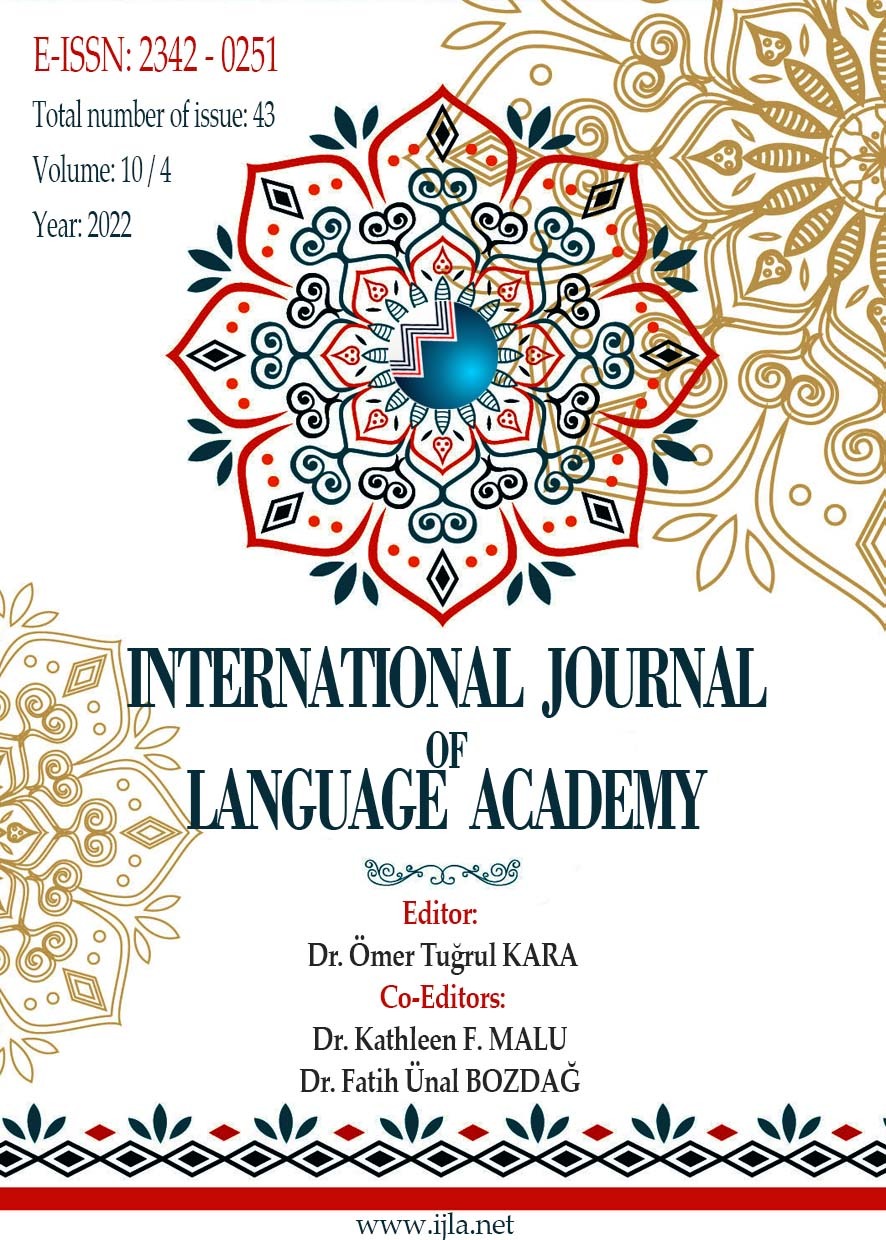FRANSIZCA-TÜRKÇE SÖZLÜKLERDEKİ ATASÖZÜ VE DEYİM ÇEVİRİLERİNİN MONA BAKER’IN ÇEVİRİ STRATEJİLERİ BAĞLAMINDA İNCELENMESİ
Author :
Abstract
Atasözü ve deyimler geçmişten günümüze aktarılan genellikle anonim olan kalıplaşmış ifadelerdir. Her dilin ve kültürün kendine özgü atasözü ve deyimleri vardır. Bu ifadeler her dilde sıklıkla kullanılmaktadır. Atasözü ve deyimleri diğer bir dile anlam kaybı olmadan aktarmak ve aynı duyguyu hedef dilde de yaşatabilmek oldukça güçtür. Atasözü ve deyimlerin çeviri sürecinde farklı stratejiler kullanılarak anlamlarının hedef dilde de aynı şekilde yansıtılması hedeflenmektedir. Bu durum çalışmanın çıkış noktasını oluşturmaktadır. Bu çalışmada Kaya Öztaş’ın Fransızca Türkçe Deyimler Sözlüğü, Suna Timur Ağıldere’nin Fransızca-Türkçe/Türkçe-Fransızca Deyimler Sözlüğü, Kaya Öztaş’ın Türkçe-Fransızca/Fransızca-Türkçe Atasözleri Sözlüğü, O.A.Gürün’ün Fransızca Deyimler Sözlüğü ve Tahsin Saraç’ın Fransızca-Türkçe Büyük Sözlüğünden rastgele seçilen atasözü ve deyim örnekleri ile Türkçe çevirileri karşılıklı çözümleme ile analiz edilmiştir. Atasözü ve deyim çeviri örnekleri Mona Baker’in benzer anlam ve benzer biçim (tam eşdeğerlik), benzer anlam ve farklı biçim (kısmi eşdeğerlik), açımlama ve çıkarma stratejileri çerçevesinde incelenmiştir. Çalışmamızda, atasözü ve deyimlerin çevirilerindeki eşdeğerlik ve farklılıkların Mona Baker’ın çeviri stratejileri çerçevesinde incelenmesi amaçlanmaktadır. Çalışmada elde edilen bulgular sonucunda, en sık olarak açımlama stratejisinin kullanıldığı görülmüştür. Bir dile veya kültüre ait olan atasözü ve deyimleri diğer bir dile aynı anlam ve biçimle aktarmak oldukça zordur. Bu sebeple, incelenen atasözü ve deyim örneklerinde biçimsel değişiklikler yapılarak hedef dilde en iyi anlam oluşturulmaya çalışılmıştır.
Keywords
Abstract
Proverbs and idioms are stereotypical expressions that are generally anonymous and transferred from the past to the present. Proverbs and idioms are a part of every language and culture. These expressions are frequently used in every language. It is extremely difficult to transfer proverbs and idioms to another language without loss of meaning and to keep the same feeling in the target language. It is aimed to reflect the meanings of proverbs and idioms in the target language in the same way by using different strategies in the translation process. This situation constitutes the starting point of the study. In this study, the examples of proverbs and idioms chosen randomly from the Kaya Öztaş's French Turkish Idioms Dictionary, Suna Timut Ağıldere's French-Turkish/Turkish-French Idioms Dictionary, Kaya Öztaş's Turkish-French/French-Turkish Proverbs Dictionary, O.A. Gür's French Idioms Dictionary and Tahsin Saraç's French-Turkish Great Dictionary and their Turkish translations were analyzed by mutual analysis. The translations examples of proverbs and idioms were analyzed in the context of Mona Baker's strategies of using an idiom of similar meaning and similar form (full equivalence), using an idiom of similar meaning but dissimilar form (partial equivalence), translation by paraphrase and translation by omission. In our study, it is aimed to analyze the equivalence and differences in translations of proverbs and idioms as part of Mona Baker's translation strategies. As a result of the findings obtained in the study, it was seen that translation by paraphrase strategy was used most frequently. It is extremely difficult to transfer proverbs and idioms belonging to one language or culture to another language with the same meaning and form. For this reason, it was tried to create the best meaning in the target language by making formal changes in the examples of proverbs and idioms analyzed.
Keywords
- Ağıldere, T.S. (2011). Fransızca-Türkçe deyimler sözlüğü. Ankara: Pegem Akademi.
- Aksan, D. (2000). Türkçenin sözvarlığı. Ankara: Engin Yayıncılık.
- Baker, M. (1992). In other word : A course book on translation. London: Routledge.
- Beekman, J. Callow, J. (1974). Translating the word of god. Michigan: Zondervan Publishing House.
- Çakır, N. E. (2018). Elif Şafak'ın the Architect's adlı romanındaki deyim ve atasözlerin Türkçe ve Fransızca çevirilerinin yorumlayıcı anlam kuramına göre karşılaştırılmalı incelenmesi (Yayımlanmamış yüksek lisans tezi). Gazi Üniversitesi Sosyal Bilimler Enstitüsü, Ankara.
- Dönmez, M. İ. (2018, Aralık). Orhan Pamuk’un sessiz ev romanındaki atasözü ve deyimlerin Arapça çevirilerinin Mona Baker çeviri stratejilerine göre incelenmesi. Jiia İnternational Journal of İnterdisciplinary and İnterculturel Art, 3(1).
- Göktürk, A. (2014). Çeviri: dillerin dili, İstanbul: Yapı Kredi Yayınları.
- Gürçağlar, Ş.T. (2019). Çevirinin ABC’si. İstanbul: Say Yayınları.
- Gürün, O. A. (1975). Fransızca deyimler sözlüğü. İstanbul: İnkilap ve Aka Kitabevleri.
- Hengirmen, M. (2007). Atasözleri ve deyimler sözlüğü 2. Ankara: Engin Yayınevi.
- Kuleli, M. (2019). Ömer Seyfettin’in herkesin içtiği su öyküsü örneğinde Türkçeden İngilizceye deyim çevirisi stratejileri. Turkish Studies- Educational Sciences, 14(5), 2487-2498.
- Kuran, N. (1995). Çağdaş Alman çeviribilimcileri. M. Rifat (Editör). Çeviri ve çeviri kuramı üstüne söylemler. İstanbul: Düzlem Yayınevi, 33-54.
- Newmark, P. (1982). Approaches to translation. Oxford: Pergamon Press.
- Öztaş, K. (1967). Türkçe-Fransızca/ Fransızca-Türkçe atasözleri. Ankara: Dil Yayınları.
- Öztaş, K. (1973). Fransızca-Türkçe deyimler sözlüğü. Ankara: Dil Yayınları.
- Saraç, T. (1976). Fransızca-Türkçe büyük sözlük. Ankara: Türk Dil Kurumu Yayınları
- Suçin, M. H (2013). Öteki dilde var olmak. İstanbul: Say Yayınları.
- Taş, S. (2017). Orhan Kemal’in 72. Koğuş adlı eserinde deyim çevirisi ve metnin yeniden anlatanı olarak çevirmen. Trakya Üniversitesi Sosyal Bilimler Dergisi, 19(1), 247259.
- Yalçın, P. (2015). Çeviri stratejileri kuram ve uygulama. Ankara: Grafiker.
- Yalçın, P., Büyüksaraç, Z. (2017). Atasözü ve deyim çevirilerinin Mona Baker çeviri stratejilerine göre incelenmesi. International Journal of Languages Education and Teaching, 5(4), 817-829.
- https://www.linternaute.fr/expression/langue-francaise/1023/a-bon-entendeur--salut/. Erişim tarihi: 10.09.2022.
- https://www.dictionnairedesfrancophones.org/form/%C3%A0%20la%20fortune%20du% 20pot. Erişim tarihi: 10.09.2022.
- https://www.linternaute.fr/expression/langue-francaise/26/casser-du-sucre-sur-le-dos- de-quelqu-un/. Erişim tarihi: 10.09.2022.
- https://www.linternaute.fr/expression/langue-francaise/437/lecher-les-bottes-a-quelqu- un/. Erişim tarihi: 10.09.2022.





